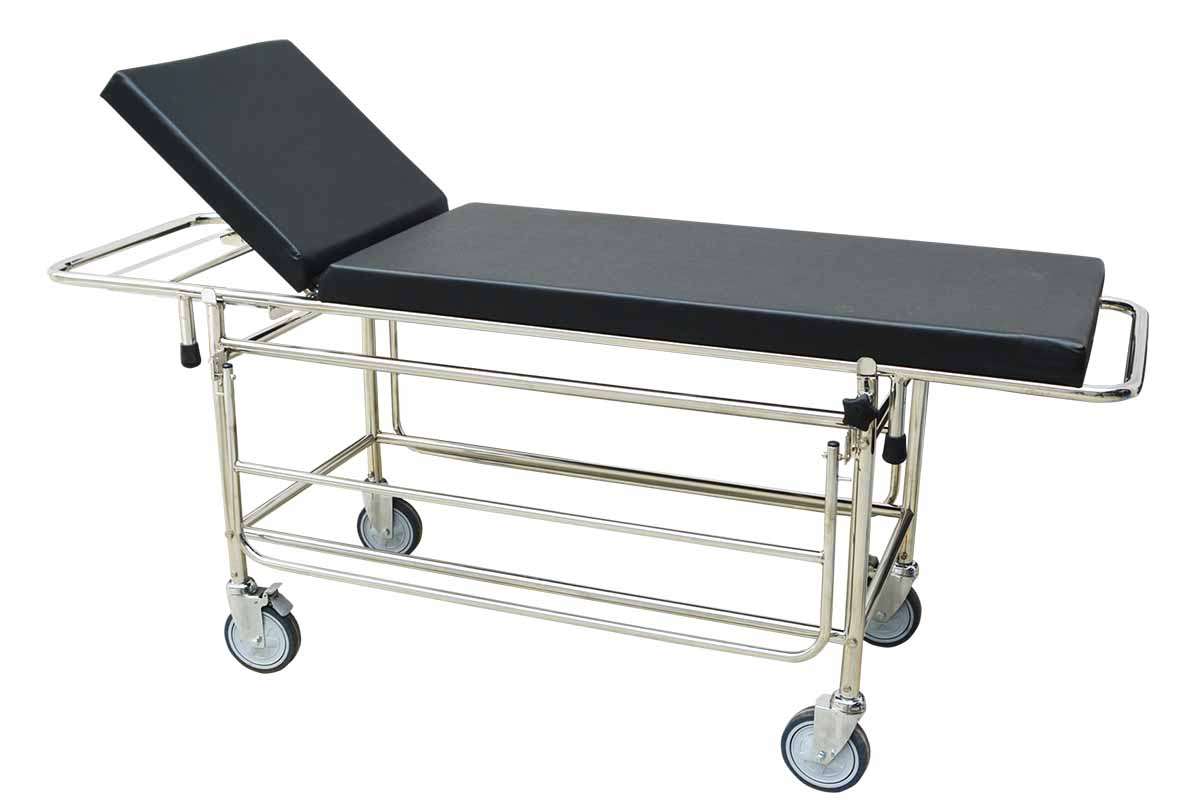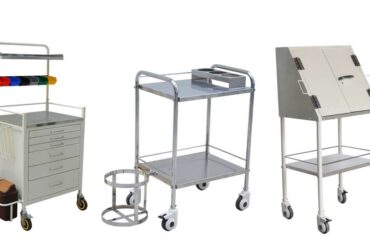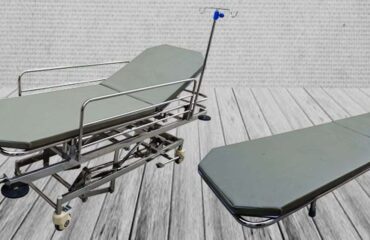A hospital stretcher trolley with side rails is a specialized piece of medical equipment used for the safe transportation, examination, and treatment of patients within a healthcare facility. It is a mobile, wheeled platform with safety and comfort features designed for both patient care and ease of handling by medical staff.

Detailed Description of a Hospital Stretcher Trolley with Side Rails
Stretcher Platform (Patient Surface)
- Structure: A firm but cushioned platform, often made of high-strength materials like stainless steel or aluminum alloy with a waterproof, antibacterial mattress.
- Function: Supports the patient in a lying or semi-reclined position during transport or emergency procedures.
- Adjustability:Headrest tilt (manual or hydraulic)Knee/leg elevation
Full Trendelenburg (head lower than feet) and Reverse Trendelenburg positions for shock management.
Trolley Frame and Mobility System
- Material: Durable and corrosion-resistant frame, usually stainless steel, carbon steel, or aluminum.
- Wheels: Four or more swivel castor wheels for maneuverability. They often include:Brakes to lock the trolley in placeCentral braking system for all wheels
Optional fifth wheel for better steering and directional control
Height Adjustability: Hydraulic or electric lifting system allows alignment with beds, operating tables, or diagnostic equipment.
Side Rails
- Design: Foldable or collapsible safety rails mounted on both sides of the stretcher.
- Material: Typically, stainless steel or high-strength polymer.
- Function:Patient safety – Prevents falls or accidental rolling off.Can be lowered for patient access during transfer or treatment.
Locking mechanism ensures rails stay secure during transport
Safety and Functional Features
- Mattress: Flame-retardant, waterproof, and easy-to-clean foam mattress.
- IV Pole: Adjustable intravenous drip stand attachment.
- Oxygen Cylinder Holder: Mounted under or along the side of the trolley.
- Restraint Belts: For securing the patient, especially during emergency transport.
- Monitor Shelf/Tray: For placing essential devices or instruments.
Usage Scenarios
- Emergency Departments: Fast patient transfers and trauma care.
- Ambulances: Trolleys can be compatible with ambulance loading systems.
- Operation Theaters: Patient preparation and recovery transport.
- Radiology & Imaging: Transfer to and from diagnostic areas like X-ray, CT, or MRI.
- Wards and ICUs: Internal transport or temporary patient holding.
Benefits of a Hospital Stretcher Trolley with Side Rails
Following are the benefits of hospital stretcher trolley with side rails: –
Enhanced Patient Safety
- Prevents falls and injuries during transport, especially for unconscious, sedated, elderly, or disoriented patients.
- Side rails act as physical barriers, ensuring patients stay securely on the stretcher.
- Restraint support: Works with straps for added security when necessary.
Safe and Efficient Patient Transport
- Enables smooth, controlled movement of patients between departments (e.g., ER, OR, imaging, wards).
- Lockable wheels and central braking systems add stability when stationary.
Adjustability for Comfort and Care
- Height, backrest, and leg support can be manually or hydraulically adjusted to suit patient needs.
- Can be set to Trendelenburg/reverse Trendelenburg positions for emergency treatment (e.g., shock or head injuries).
Hygiene and Infection Control
- Surfaces are made with antibacterial, waterproof materials that are easy to clean.
- Reduces risk of cross-contamination between patients.
Improved Workflow for Healthcare Staff
- Ergonomic design minimizes physical strain on nurses and paramedics during lifting or transferring.
- Side rails fold down easily, allowing seamless patient transfer to beds or diagnostic tables.
- Compatible with IV poles, oxygen holders, and emergency equipment.
Versatile Use Across Departments
- Suitable for use in emergency rooms, ICUs, wards, radiology, and operating rooms.
- Reduces need for multiple types of equipment—a multi-functional asset.
Optional Technology Integration
- Advanced models support monitoring devices, power-assisted movement, or X-ray compatibility, enhancing diagnostic and treatment efficiency without transferring the patient.
Cost-Effective Patient Handling
- Reduces injury risks, limiting potential costs related to patient falls or staff overexertion.
- Durable construction ensures long-term usability, lowering replacement frequency.


